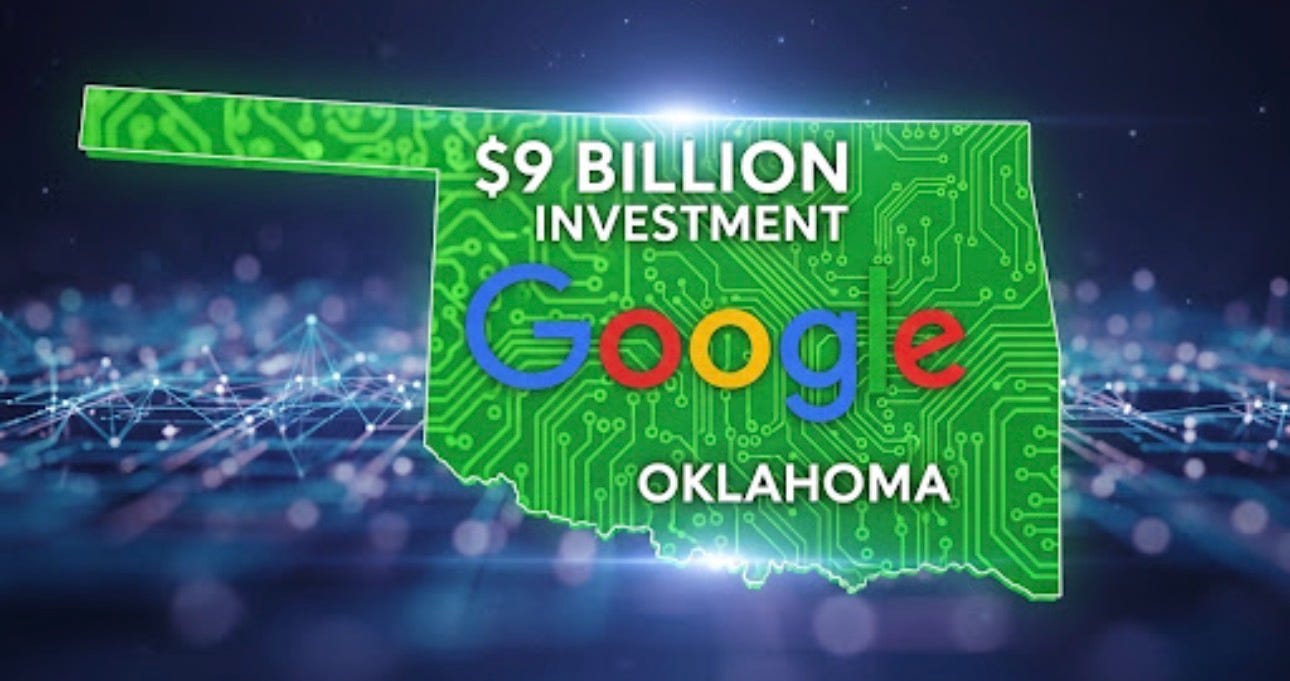Google’s $9 Billion Investment: Powering Oklahoma’s AI Future and Synergizing National Tech Growth
In a landmark move announced on August 13, 2025, Google has committed $9 billion over the next two years to expand its cloud and AI infrastructure in Oklahoma. This investment aims to meet the surging demand for digital services, positioning the state as a key player in America’s AI revolution. As part of the “Synergizing America” newsletter, we’ll break down what this means for Oklahoma’s economy, workforce, and education—while highlighting Google’s longstanding footprint in the Sooner State. We’ll also explore the growing energy demands of AI and how Oklahoma’s energy resources likely influenced Google’s decision.
The Core of the Announcement: Infrastructure Expansion
Google’s plan focuses on two main sites:
Google is expanding its existing data center in Pryor, Mayes County, which has been operational since 2007.
Google is building a new state-of-the-art, energy-efficient campus in Stillwater to support advanced AI and cloud computing.
These developments are driven by the need for robust infrastructure to handle AI workloads, such as machine learning models and data storage. In simple terms, think of it as building bigger, smarter “digital warehouses” to store and process the vast amounts of information powering everything from search engines to smart assistants. A key factor in site selection appears to be Oklahoma’s abundant resources, including land, workforce, and, crucially, energy availability. Google evaluates locations based on these elements, and Oklahoma’s “magic combination” includes proximity to power generation facilities and access to low-cost, reliable energy from sources like natural gas. The state has drawn tech investments partly due to its energy infrastructure, with Google already signing power purchase agreements for solar projects to support its operations here.
Boosting Workforce and Education
Beyond bricks and mortar, Google’s investment emphasizes human capital:
Google is funding the electrical training ALLIANCE to increase Oklahoma’s electrical workforce by 135%, addressing the energy demands of data centers and supporting new energy infrastructure.
Google is partnering with the University of Oklahoma and Oklahoma State University through its AI for Education Accelerator, providing free AI training and career certificates as part of a broader $1 billion national commitment to equip Americans with future-ready skills.
These efforts are expected to create thousands of jobs, from construction to tech roles, fostering long-term economic synergy between industry and education.
Broader Impact: Oklahoma as an AI Hub
Governor Kevin Stitt hailed this as the largest investment in Oklahoma’s history, underscoring its role in “deepening roots” for tech innovation. By enhancing AI capabilities, Google is helping the state attract more businesses and talent, turning rural areas into tech hotspots. This aligns with national goals to keep America competitive in AI against global rivals.
Outlook on Energy Usage for AI
AI’s rapid growth comes with a steep energy cost. Data centers, the backbone of AI, are projected to consume massive amounts of electricity in the coming years. Globally, demand could double to around 945 terawatt-hours (TWh) by 2030, driven largely by AI workloads. In the U.S., power use for data centers is expected to more than double by 2035, rising from 35 gigawatts in 2024 to 78 gigawatts. By the end of 2025, AI could account for up to 49% of total data center power consumption, with global AI energy needs reaching 200 TWh—equivalent to the annual electricity use of some small countries. This surge is straining grids and pushing companies like Google toward locations with reliable, scalable energy, while also emphasizing clean sources to reduce emissions.
Google’s Existing Assets in Oklahoma
Google’s presence in Oklahoma isn’t new—it dates back nearly two decades. Key current assets include:
Google’s Mayes County data center serves as the cornerstone facility in Pryor, where the company has invested over $5.7 billion since 2007.
Google has provided more than $7 million in grants and donations since 2008, plus over $5 million in donated search ads to nonprofits in 2024.
Google’s tools generated $2.2 billion in economic activity in 2024 for over 235,000 Oklahoma businesses, creators, and developers.
No additional offices or major facilities are noted beyond the Pryor site, making this expansion a natural evolution of Google’s commitment.
Synergizing America’s Future
This $9 billion infusion exemplifies how tech giants like Google are synergizing with states to build a resilient, innovative economy. By blending infrastructure, education, community investment, and strategic energy access, Oklahoma is set to thrive in the AI era—contributing to a stronger, more connected America. Stay tuned to “Synergizing America” for more on how such partnerships drive national progress.
What are your thoughts on this investment? Share in the comments below!





How much does Oklahoma’s wind capacity likely play into their decisions? OK is such a large producer but I’m not sure where all of it goes